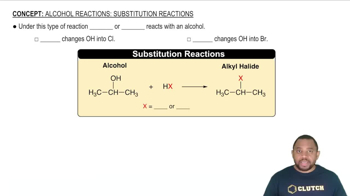Which of these statements about alloys and intermetallic compounds is false? (a) Bronze is an example of an alloy. (b) 'Alloy' is just another word for 'a chemical compound of fixed composition that is made of two or more metals.' (c) Intermetallics are compounds of two or more metals that have a definite composition and are not considered alloys. (d) If you mix two metals together and, at the atomic level, they separate into two or more different compositional phases, you have created a heterogeneous alloy. (e) Alloys can be formed even if the atoms that comprise them are rather different in size.
Ch.12 - Solids and Modern Materials
Chapter 12, Problem 43
For each of the following alloy compositions, indicate whether you would expect it to be a substitutional alloy, an interstitial alloy, or an intermetallic compound: (a) Fe0.97Si0.03 (b) Fe0.60Ni0.40 (c) SmCo5.
 Verified step by step guidance
Verified step by step guidance1
Identify the elements involved in the alloy composition: Iron (Fe) and Nickel (Ni).
Understand the nature of the elements: Both Fe and Ni are similar in size and are neighboring elements in the periodic table, which suggests they can replace each other in the lattice structure.
Determine the type of alloy based on the atomic sizes and properties: Since both elements are similar in size and can replace each other in the lattice, this suggests a substitutional alloy.
Consider the composition ratio: The ratio of Fe to Ni is 0.60 to 0.40, which supports the idea of a substitutional alloy where one type of atom substitutes for another in the crystal structure without distorting it.
Conclude the type of alloy: Given the similar atomic radii and the ability to form solid solutions, Fe0.60Ni0.40 is likely a substitutional alloy.

Verified video answer for a similar problem:
This video solution was recommended by our tutors as helpful for the problem above.
Video duration:
3mWas this helpful?
Key Concepts
Here are the essential concepts you must grasp in order to answer the question correctly.
Substitutional Alloys
Substitutional alloys are formed when atoms of one metal replace or substitute for atoms of another metal in the crystal lattice. This typically occurs when the two metals have similar atomic sizes and crystal structures, allowing for a uniform distribution of the alloying elements. An example is brass, which is an alloy of copper and zinc.
Recommended video:
Guided course

Alcohol Reactions: Substitution Reactions
Interstitial Alloys
Interstitial alloys are created when smaller atoms fit into the spaces (interstices) between the larger metal atoms in a crystal lattice. This type of alloy often involves a significant difference in atomic size, such as carbon atoms in iron to form steel. The presence of these smaller atoms can enhance the strength and hardness of the alloy.
Intermetallic Compounds
Intermetallic compounds are distinct phases formed between two or more metals that have a specific stoichiometric ratio and a defined crystal structure. Unlike substitutional or interstitial alloys, intermetallics exhibit unique properties and often have different physical and chemical characteristics than their constituent metals. An example is the compound Ni3Al, which has specific applications in high-temperature environments.
Recommended video:
Guided course

Ionic Compounds Naming
Related Practice
Textbook Question
Textbook Question
Determine if each statement is true or false: (a) Substitutional alloys are solid solutions, but interstitial alloys are heterogenous alloys. (c) The atomic radii of the atoms in a substitutional alloy are similar to each other, but in an interstitial alloy, the interstitial atoms are a lot smaller than the host lattice atoms.
Textbook Question
Determine if each statement is true or false: (b) Substitutional alloys have 'solute' atoms that replace 'solvent' atoms in a lattice, but interstitial alloys have 'solute' atoms that are in between the 'solvent' atoms in a lattice.
Textbook Question
Indicate whether each statement is true or false: (c) Nonmetallic elements are never found in alloys.
